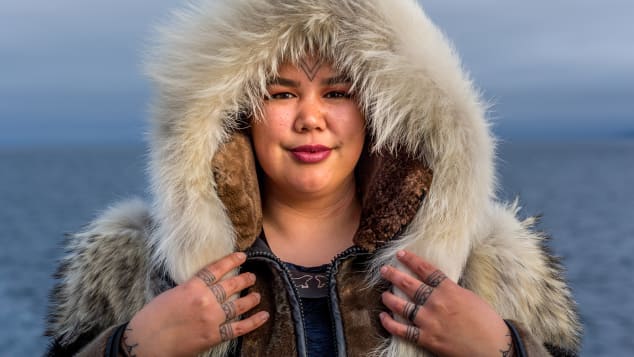
Tattoos have been used in many different cultures and in many different ways around the world for thousands of years. In some places tattoos carry a stigma, but in others such as the Inuit, they are held as a great tradition. These tattoos are the traditional markings of Inuit women and a big part of Inuit culture. The Inuit are the indigenous peoples of Canada and Alaska (Fun Fact: If you know the character Katara from Avatar: The Last Airbender, her and the water tribe are Inuit). For thousands of years Inuit women have been marking their faces, chins, arms, etc. with needles made of bones or sinew soaked with suet (the hard white fat on the kidneys and loins of cattle and other animals).

These traditional markings also represent a deeper meaning in Inuit myths, the story of Sedna the sea goddess. Sedna was a beautiful woman who had many men asking for her hand in marriage, but she denied them all. One day a man came to Sedna and promised her an abundance of food, furs, and blankets if she married him. She said yes and the man took her to an island, only to reveal that he was not a man but a bird. As he was a bird he could not hunt, and only could catch fish. Sedna lived unhappily until her father came, and when he saw how she was living he killed the bird. As they got into a kayak and tried to go home the bird’s friends caught Sedna and her father and flapped their wings angrily creating a huge storm. Sedna’s father was scared of going overboard and drowning so he threw Sedna off. As Sedna held on to the kayak and wouldn’t let go he chopped off her fingers at the joint. As her fingers fell they became sea animals. She then sank to the sea floor and became a spirit who controls all sea animals. The traditional markings on Inuit women’s hands and arms represent where Sedna’s hands and arms were chopped off.


These tattoos were a source of pride for Inuit women and recognized their beauty, lives, and important accomplishments such as skinning a fox or sewing a seal-skin parka. A V on the forehead meant entering womanhood, and a Y tattoo represents a tool used to hunt seals, which is a staple in Inuit diet.
Though these tattoos were used to recognize accomplishments and were meant to be a source of pride, when colonists arrived in Canada they did not think the same thing. Like many other indigenous cultural practices, during the period of colonialism tattoos were banned (they were said to be evil and satanic), Inuit women ceased getting their traditional tattoos, and tattoos were dying out with the older generations. But today, many Inuit women are fighting to keep their traditional markings going and reclaim their cultural pride in their tattoos.
cxb5766
January 28, 2021 at 5:03 pmFirst of all, I love the concept of this blog. Anthropology is something I’ve always been interested in ever since I read The English Patient.
In recent decades there has been a stigma against tattoos, especially in the work force. Teenagers are often warned by their parents not to get tattoos (or at least visible ones) or else they won’t be “employable.” This is true in some work forces more than others. My older brother, who is dying to get a tattoo, has thus far held off on it because he’s in business. I myself would have less reservations about it because I’m an electrical engineer major, and tech companies seem to be less stringent on dress code.
I wonder if this modern sentiment about tattoos has ties back to when colonists arrived to North America and believed them to be “evil and satanic” as you said. Since the occupations where tattoos are frowned upon are related to the government and capitalism — law enforcement, healthcare, the corporate world — this theory may follow through.
mxd5728
January 28, 2021 at 10:21 pmI love the aesthetic of your blog. The whole site looks great! I’d personally never want to get a tattoo, but I do think they look awesome it was really interesting learning about where they come from and what they meant to some different cultures and people across time. This was a great blog post! Thanks for sharing this info.